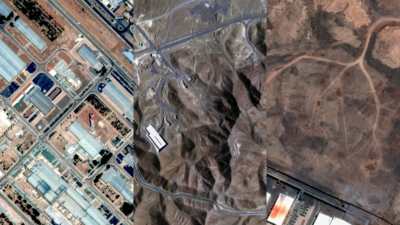Before & after: Satellite images show damage caused to Iran’s Fordo, Isfahan, Natanz nuclear sites after US strike; see pics

New satellite imagery has revealed significant damage to Iran’s key nuclear facilities following Saturday’s US strikes. Iran has warned of consequences while maintaining a measured initial response.Satellite photos from Maxar Technologies show multiple impact sites at the Fordo nuclear facility, including new craters, potentially collapsed tunnel entrances, and holes along a mountain ridge. While a large support building used for ventilation control remained intact, the status of the underground uranium enrichment centrifuges remains unconfirmed. The International Atomic Energy Agency (IAEA) reported no radiation releases from the site.At Natanz, another critical nuclear site, imagery revealed a new 5.5-meter (18-foot) diameter crater directly above part of the underground enrichment facility. However, the images don’t conclusively show whether the strikes penetrated the heavily fortified facility, which lies 40 meters underground and is protected by an 8-meter thick concrete and steel shell.Fordo Nuclear facilityFordo, situated approximately 100 kilometers southwest of Tehran, is a heavily fortified uranium enrichment facility built deep within a mountain. Its existence remained secret until Western intelligence uncovered it in 2009. Though smaller than Natanz, Fordo’s mountain protection and anti-aircraft systems make it an exceptionally challenging military target.
The facility houses sophisticated centrifuges for uranium enrichment. Its deep underground location means that only specialised weapons, specifically the US-made GBU-57 “bunker buster” bombs, could potentially penetrate its defences. These 30,000-pound bombs can only be delivered by American B-2 Spirit stealth bombers, making any serious attack on Fordo virtually impossible without direct US military involvement.Natanz Nuclear FacilityNatanz, located 220 kilometers southeast of Tehran, serves as Iran’s primary uranium enrichment centre. The facility has been a frequent target of Israeli military operations and has experienced significant damage both above and below ground.
According to the International Atomic Energy Agency (IAEA), Natanz had achieved uranium enrichment levels of 60% purity, approaching weapons-grade material. The facility has suffered multiple setbacks, including damage from Israeli airstrikes and the notorious Stuxnet cyberattack, believed to be a joint US-Israeli operation. In response to these vulnerabilities, Iran began constructing new sections deeper underground near Kuh-e Kolang Gaz La (Pickax Mountain) to better protect its operations. Despite the attacks, the IAEA has confirmed that radioactive contamination has remained contained within the facility.Isfahan Nuclear Technology CenterThe Isfahan facility, positioned 350 kilometers southeast of Tehran, functions as Iran’s principal nuclear research facility. This expansive complex employs thousands of scientists and features three Chinese-supplied research reactors.
The site includes essential laboratories and a uranium conversion facility, crucial for the initial stages of nuclear fuel production. While the facility has been targeted by Israeli strikes, particularly the conversion plant, the IAEA has verified that these attacks have not resulted in any radiation leakage or elevated radiation levels in the surrounding areas.





